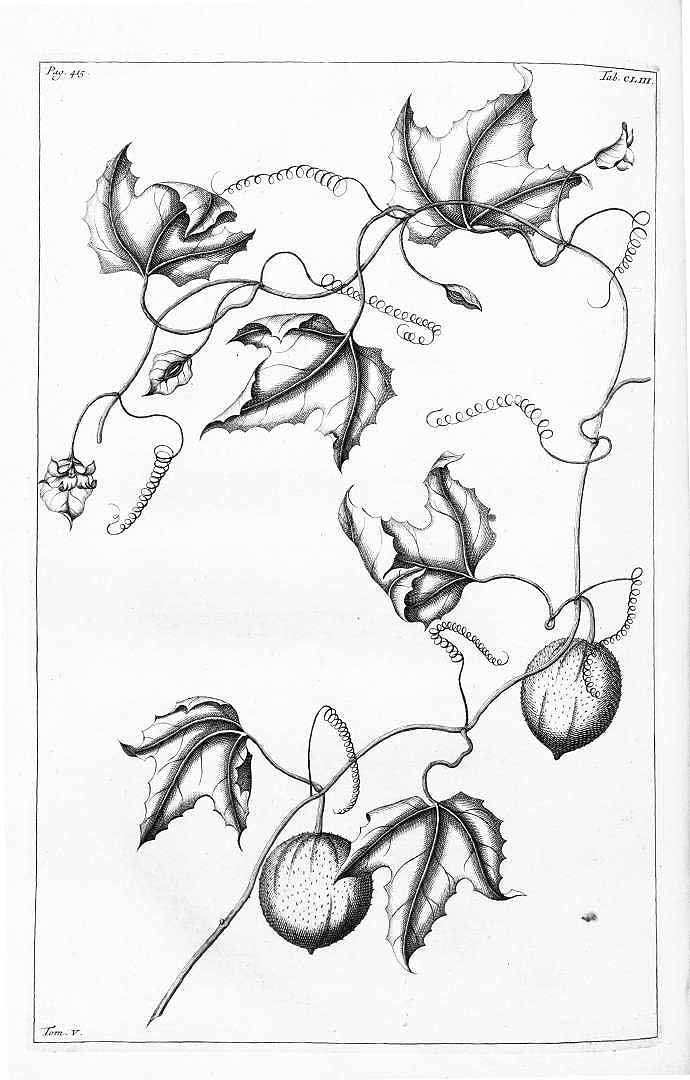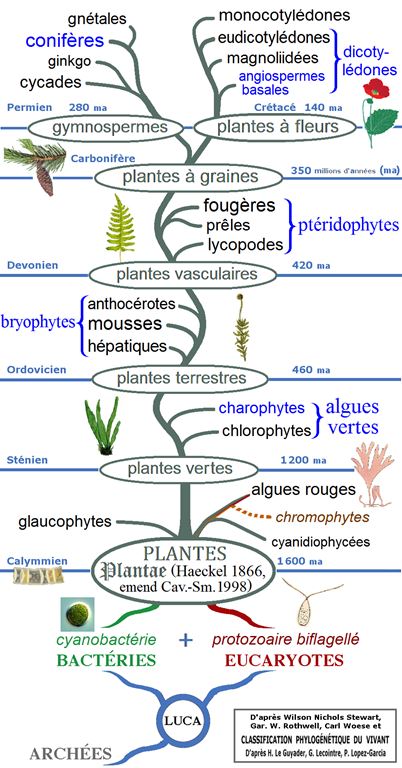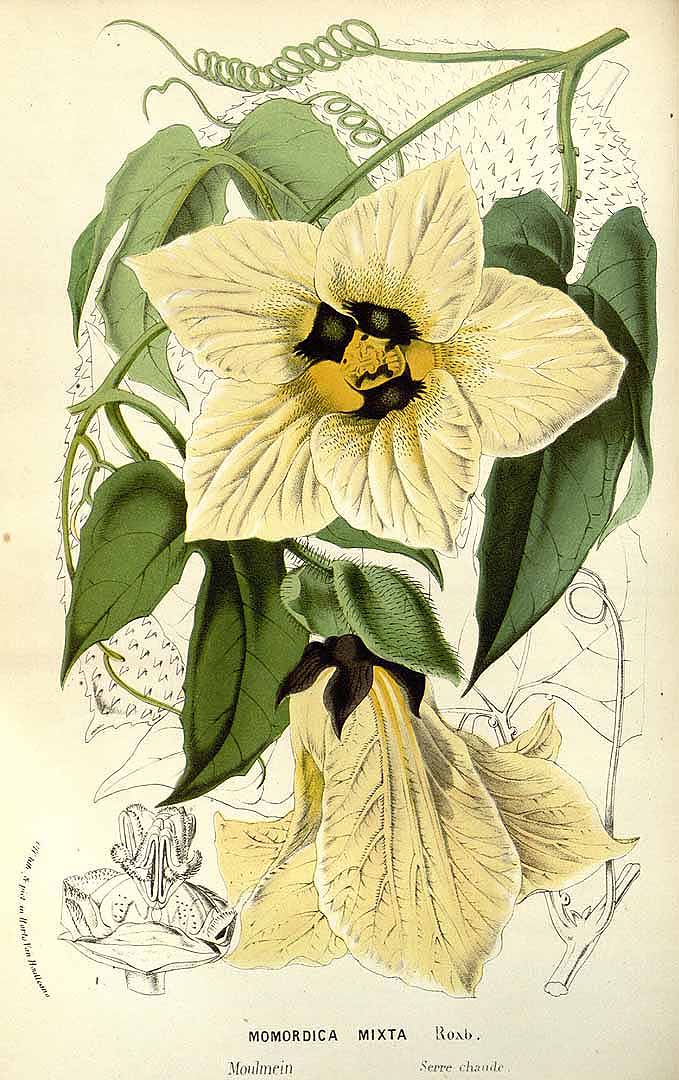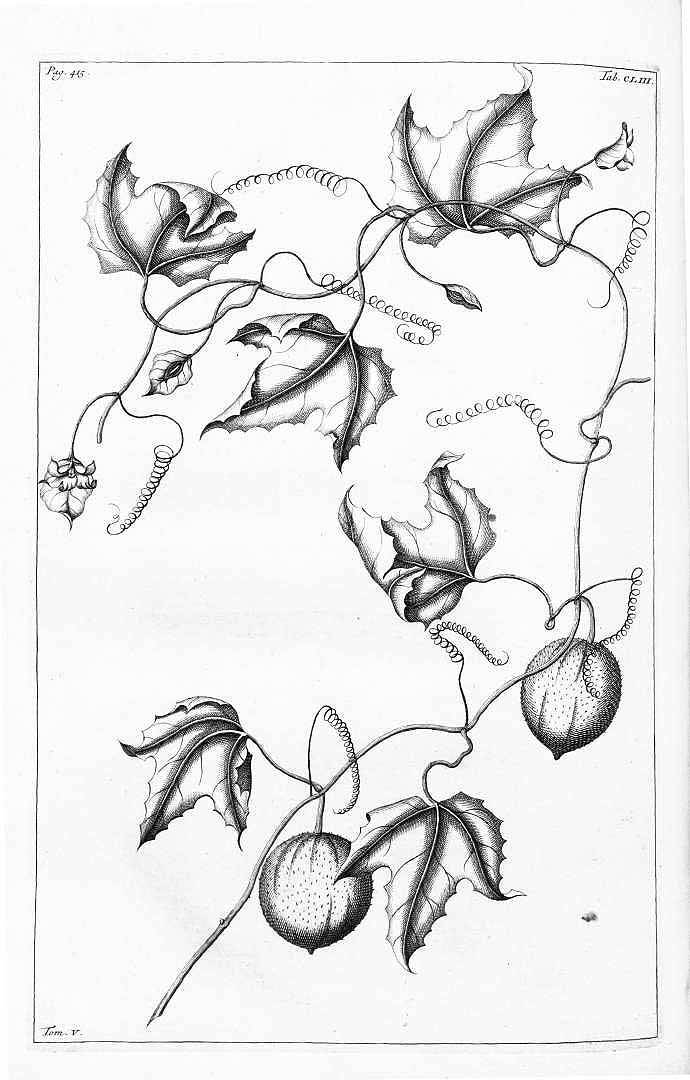Muricie
(Momordica cochinchinensis)

Une plante de la famille des citrouilles. C'est une vigne grossière atteignant 15 m de long. Il continue de croître d'année en année. Il a des racines tubéreuses. Il grim ... (traduction automatique)
→suite
Muricie 

Une plante de la famille des citrouilles. C'est une vigne grossière atteignant 15 m de long. Il continue de croître d'année en année. Il a des racines tubéreuses. Il grimpe au moyen de vrilles. Il est légèrement velu. Les feuilles mesurent 8 à 18 cm de long, 8 à 20 cm de diamètre et sont profondément 3 lobé... (traduction automatique) →suite
Classification
- Classique : en haut de l\'écran, sous le coeur.
- Phylogénétique :
- Clade 4 : Angiospermes ;
- Clade 3 : Dicotylédones_vraies ;
- Clade 2 : Rosidées ;
- Clade 1 : Fabidées ;
- Ordre APN : Cucurbitales ;
- Famille APN : Cucurbitaceae ;
Illustration : cet arbre phylogénétique des plantes montre les principaux clades et groupes traditionnels (monophylétiques en noir et paraphylétiques en bleu).
Dénominations
✖- Nom botanique : Momordica cochinchinensis (Lour.) Spreng. (1826)
- Synonymes français : gac
- Synonymes : Momordica macropylla Gage, Momordica meloniflora Hand.Mazz, Momordica mixta Roxb, Muricia cochinchinensis Lour, Zucca commersoniana Ser
- Noms anglais et locaux : balsam-pear, Chinese bitter-cucumber, Chinese-cucumber, giant spine gourd, spiny bitter-cucumber (spiny bitter cucumber), sweet gourd, mu bie zi (cn transcrit), indische Bittergurke (de), cundeamor (es), taggig bittergurka (sv), bhat karela (local)
Description et culture
✖Nombre de graines au gramme :
0,25
- dont infos de "FOOD PLANTS INTERNATIONAL" :
Description :
Une plante de la famille des citrouilles. C'est une vigne grossière atteignant 15 m de long. Il continue de croître d'année en année. Il a des racines tubéreuses. Il grimpe au moyen de vrilles. Il est légèrement velu. Les feuilles mesurent 8 à 18 cm de long, 8 à 20 cm de diamètre et sont profondément 3 lobées et la base est en forme de cœur. Les feuilles sont d'un vert vif. Les tiges des feuilles mesurent 2 à 10 cm de long. Les fleurs mâles et femelles sont séparées sur la même plante. Les fleurs mâles mesurent 3,5 cm de diamètre sur des tiges de 5 à 30 cm de long. Les pétales sont jaune pâle. Les fleurs femelles sont plus petites. Les fruits sont en forme d'oeuf, jaunes et rugueux avec de petites bosses éparpillées dessus. Ils sont comestibles. La chair est rouge orangé. Les graines sont brun noirâtre{{{0(+x) (traduction automatique).
Original : A pumpkin family plant. It is a coarse vine up to 15 m long. It keeps growing from year to year. It has tuberous roots. It climbs by means of tendrils. It is slightly hairy. The leaves are 8 to 18 cm long, and 8-20 cm across and deeply 3 lobed and the base is heart shaped. Leaves are bright green. The leaf stalks are 2-10 cm long. Male and female flowers are separate on the same plant. Male flowers are 3.5 cm across on stalks 5-30 cm long. The petals are pale yellow. The female flowers are smaller. The fruit are egg shaped, yellow and roughened with small bumps scattered over it. They are edible. The flesh is orange-red. The seeds are blackish-brown{{{0(+x).
Production :
Une plante peut produire 4 kg de fruits. Il peut y avoir 20-25 fruits. Au Sikkim, les fruits sont disponibles de juin à juillet{{{0(+x) (traduction automatique).
Original : One plant can produce 4 kg of fruit. There can be 20-25 fruit. In Sikkim fruit are available June to July{{{0(+x).
Culture :
Les plantes peuvent être cultivées à partir de graines ou de boutures de jeunes pousses fermes. Les racines tubéreuses peuvent être utilisées. Les plantes sont espacées de 130 cm{{{0(+x) (traduction automatique).
Original : Plants can be grown from seed or cuttings of firm young growth. The tuberous roots can be used. The plants are spaced 130 cm apart{{{0(+x).
 Consommation (rapports de comestibilité, parties utilisables et usages alimentaires correspondants)
Consommation (rapports de comestibilité, parties utilisables et usages alimentaires correspondants)
✖
Partie(s) comestible(s){{{0(+x) : feuilles, légume, fruit, épice{{{0(+x).
Utilisation(s)/usage(s) comestible(s){{{0(+x) :
-les jeunes pousses feuillues sont consommées cuites{{{0(+x) (ex. : comme potherbe{{{(dp*)) ; elles sont souvent blanchies puis servies avec une sauce chili ou ajoutées aux soupes ;
-le jeune fruit est cuit et mangé comme un légume ; ils sont cuits, sautés ou utilisé dans les currys{{{0(+x).
Partie testée :
fruit{{{0(+x) (traduction automatique). Original : Fruit{{{0(+x)| Taux d'humidité | Énergie (kj) | Énergie (kcal) | Protéines (g) |
|---|---|---|---|
| 90 | 120 | 29 | 0.6 |
| Pro- vitamines A (µg) |
Vitamines C (mg) | Fer (mg) | Zinc (mg) |
| / | / | / | / |
 Risques et précautions à prendre
Risques et précautions à prendre
✖
néant, inconnus ou indéterminés.
Galerie(s)
✖Autres infos
✖dont infos de "FOOD PLANTS INTERNATIONAL" :
Statut :
Les fruits sont vendus sur les marchés. Leaves sont vendus sur les marchés locaux{{{0(+x) (traduction automatique).
Original : Fruit are sold in markets. Leaves are sold in local markets{{{0(+x).
Distribution :
Une plante tropicale. Il convient aux endroits tropicaux mais pousse également dans les climats chauds et humides. Il se produit du nord de Luzon au sud de Mindanao aux Philippines. Dans XTBG Yunnan. Au Sichuan{{{0(+x) (traduction automatique).
Original : A tropical plant. It suits tropical places but also grows in warm humid climates. It occurs from northern Luzon to southern Mindanao in the Philippines. In XTBG Yunnan. In Sichuan{{{0(+x).
Localisation :
Asie, Australie, Bangladesh, Cambodge, Chine, Cuba, Himalaya, Inde, Indochine, Indonésie, Laos, Malaisie, Myanmar, Nord-est de l'Inde, Pacifique, Papouasie-Nouvelle-Guinée, PNG, Philippines, Asie du Sud-Est, Sikkim, Taïwan, Thaïlande, Vietnam{{{0(+x) (traduction automatique).
Original : Asia, Australia, Bangladesh, Cambodia, China, Cuba, Himalayas, India, Indochina, Indonesia, Laos, Malaysia, Myanmar, Northeastern India, Pacific, Papua New Guinea, PNG, Philippines, SE Asia, Sikkim, Taiwan, Thailand, Vietnam{{{0(+x).
Notes :
Il existe environ 50 espèces de Momordica{{{0(+x) (traduction automatique).
Original : There are about 50 Momordica species{{{0(+x).
Liens, sources et/ou références
✖Sources et/ou références :
dont classification : "The Plant List" (en anglais) ; "GRIN" (en anglais) ;
dont livres et bases de données : 0"Food Plants International" (en anglais) ;
Le Truffaut du Potager (collectif, éditions Larousse, 2010) / détails du livre
dont biographie/références de "FOOD PLANTS INTERNATIONAL" :
Ambasta, S.P. (Ed.), 2000, The Useful Plants of India. CSIR India. p 378 ; Bandyopadhyay, S. et al, 2009, Wild edible plants of Koch Bihar district, West Bengal. Natural Products Radiance 8(1) 64-72 ; Borrell, O.W., 1989, An Annotated Checklist of the Flora of Kairiru Island, New Guinea. Marcellin College, Victoria Australia. p 66, 183 ; Brown, W.H., 1920, Wild Food Plants of the Philippines. Bureau of Forestry Bulletin No. 21 Manila. p 154 ; Burkill, I.H., 1966, A Dictionary of the Economic Products of the Malay Peninsula. Ministry of Agriculture and Cooperatives, Kuala Lumpur, Malaysia. Vol 2 (I-Z) p 1511 ; Cooper, W. and Cooper, W., 2004, Fruits of the Australian Tropical Rainforest. Nokomis Editions, Victoria, Australia. p 142 ; Dhyani, S.K., & Sharma, R.V., 1987, Exploration of Socio-economic plant resources of Vyasi Valley in Tehri Garwhal. J. Econ. Tax. Bot. Vol. 9 No. 2 pp 299-310 ; Elliot, W.R., & Jones, D.L., 1993, Encyclopedia of Australian Plants suitable for cultivation. Vol 6. Lothian. p 441 ; Facciola, S., 1998, Cornucopia 2: a Source Book of Edible Plants. Kampong Publications, p 88 ; Flora of Australia, Volume 8, Lecythidales to Batales, Australian Government Publishing Service, Canberra (1982) p 167 ; Hani Medicine of Xishuangbanna, 1999, p 115 ; Jacquat, C., 1990, Plants from the Markets of Thailand. D.K. Book House p 56 ; Japanese International Research Centre for Agricultural Science www.jircas.affrc.go.jp/project/value_addition/Vegetables ; Khumgratok, S., Edible Plants in Cultural Forests of Northeastern Thailand. Mahasarakham University Thailand. ; Kuo, W. H. J., (Ed.) Taiwan's Ethnobotanical Database (1900-2000), https://tk.agron.ntu.edu.tw/ethnobot/DB1.htm ; Martin, F.W. & Ruberte, R.M., 1979, Edible Leaves of the Tropics. Antillian College Press, Mayaguez, Puerto Rico. p 190 ; McMakin, P.D., 2000, Flowering Plants of Thailand. A Field Guide. White Lotus. p 47 ; Menisa, A. A., et al, 2012, Survey and characterization of Indigenous Food Plants in Ilocos Norte, Philippines. SEARCA Discussion Paper series No. 2011-2 ; Monsalud, M.R., Tongacan, A.L., Lopez, F.R., & Lagrimas, M.Q., 1966, Edible Wild Plants in Philippine Forests. Philippine Journal of Science. p 456 ; Pham-Hoang Ho, 1999, An Illustrated Flora of Vietnam. Nha Xuat Ban Tre. p 568 ; PROSEA handbook Volume 13 Spices. p 277 ; Rashid, H. E., 1977, Geography of Bangladesh. Westview. p 264 ; Sharma, B.B., 2005, Growing fruits and vegetables. Publications Division. Ministry of Information and broadcasting. India. p 188 ; Singh, H.B., Arora R.K.,1978, Wild edible Plants of India. Indian Council of Agricultural Research, New Delhi. p 77 ; Singh, P.K., Singh, N.I., and Singh, L.J., 1988, Ethnobotanical Studies on Wild Edible Plants in the Markets of Manipur - 2. J. Econ. Tax. Bot. Vol. 12 No. 1 pp 113-119 ; Slik, F., www.asianplant.net ; Solomon, C., 2001, Encyclopedia of Asian Food. New Holland. p 41 ; Syst. veg. 3:14. 1826 ; Terra, G.J.A., 1973, Tropical Vegetables. Communication 54e Royal Tropical Institute, Amsterdam, p 59 ; Tindall, H.D., 1983, Vegetables in the tropics. Macmillan p. 181 ; USDA, ARS, National Genetic Resources Program. Germplasm Resources Information Network - (GRIN). [Online Database] National Germplasm Resources Laboratory, Beltsville, Maryland. Available: www.ars-grin.gov/cgi-bin/npgs/html/econ.pl (10 April 2000) ; Van Sam, H. et al, 2008, Uses and Conservation of Plant Species in a National Park. A case study of Ben En, Vietnam. Economic Botany 62:574-593 ; Xu, You-Kai, et al, 2004, Wild Vegetable Resources and Market Survey in Xishuangbanna, Southwest China. Economic Botany. 58(4): 647-667. (As Momordica macrophylla) ; Yang, Si-Lin and Walters, T. W., 1992, Ethnobotany and the role of the Cucurbitaceae of China. Economic Botany, Vol. 46, No. 4, pp. 349-367
Recherche de/pour :
- "Momordica cochinchinensis" sur Google (pages et
images) ;
TROPICOS (en anglais) ;
Tela Botanica ;
Pl@ntNet ;
Pl@ntUse ;
- "Muricie" sur Google (pages, images et recettes) ;
- "Momordica cochinchinensis" sur Google (pages et
images) ;
TROPICOS (en anglais) ;
Tela Botanica ;
Pl@ntNet ;
Pl@ntUse ;
Espèces du même genre (Momordica)
✖18 taxons
- Momordica anigosantha
- Momordica balsamina L. (Pomme de merveille)
- Momordica boivinii Baill.
- Momordica calantha
- Momordica cardiospermoides
- Momordica charantia L. (Margose à piquants)
- Momordica cissoides
- Momordica cochinchinensis (Lour.) Spreng. (Muricie)
- Momordica cymbalaria
- Momordica dioica Roxb. ex Willd.
- Momordica foetida
- Momordica pterocarpa
- Momordica rostrata A.Zimm.
- Momordica sahyadrica
- Momordica spinosa
- Momordica subangulata
- Momordica trifoliolata
- Momordica tuberosa
Espèces de la même famille (Cucurbitaceae)
✖50 taxons (sur 251)
- Abobra tenuifolia (Hook. & Arn.) Cogn.
- Acanthosicyos horridus Welw. ex Benth. & Hook.f. (Melon épineux)
- Acanthosicyos naudinianus (Sonder) Jeffrey
- Actinostemma lobata
- Actinostemma paniculatum Maxim. ex Cogn.
- Actinostemma tenerum
- Ampelosicyos major
- Ampelosicyos scandens
- Apodanthera biflora
- Apodanthera herrerae Harms
- Apodanthera mandonii
- Apodanthera palmeri S. Watson
- Apodanthera undulata A. Gray (Melon de coyote)
- Benincasa hispida (Thunb.) Cogn. (Courge à la cire)
- Bryonia alba
- Bryonia cretica L.
- Bryonia dioica Jacq. (Bryone dioïque)
- Bryonopsis heterophylla
- Calycophysum weberbaueri
- Cayaponia capitata
- Cayaponia diversifolia
- Cayaponia laciniosa
- Cayaponia podantha
- Cayaponia ruizii
- Cayaponia selysioides
- Cayaponia sp.
- Cayaponia trilobata
- Cephalopentandra ecirrhosa
- Ceratosanthes hilariana
- Ceratosanthes palmata
- Cionosicyos macranthus
- Citrullus colocynthis (L.) Schrad. (Coloquinte)
- Citrullus ecirrhosus Cogn.
- Citrullus lanatus (Thunb.) Matsum. & Nakai (Pastèque)
- Citrullus rehmii De Winter
- Coccinia abyssinica (Lam.) Cogn. (Anchote)
- Coccinia adoensis (A.Rich.) Cogn. (Mutkuru)
- Coccinia barteri
- Coccinia grandis (L.) J. Voigt (Gourde écarlate)
- Coccinia hirtella
- Coccinia megarrhiza C.Jeffrey
- Coccinia mildbraedii Harms
- Coccinia ogadensis
- Coccinia palmata
- Coccinia quinqueloba
- Coccinia rehmannii Cogn.
- Coccinia schliebenii
- Coccinia sessilifolia (Sond.) Cogn.
- Coccinia trilobata (Cogn.) C.Jeffrey (Koba)
- Cogniauxia podolaena
- ...






